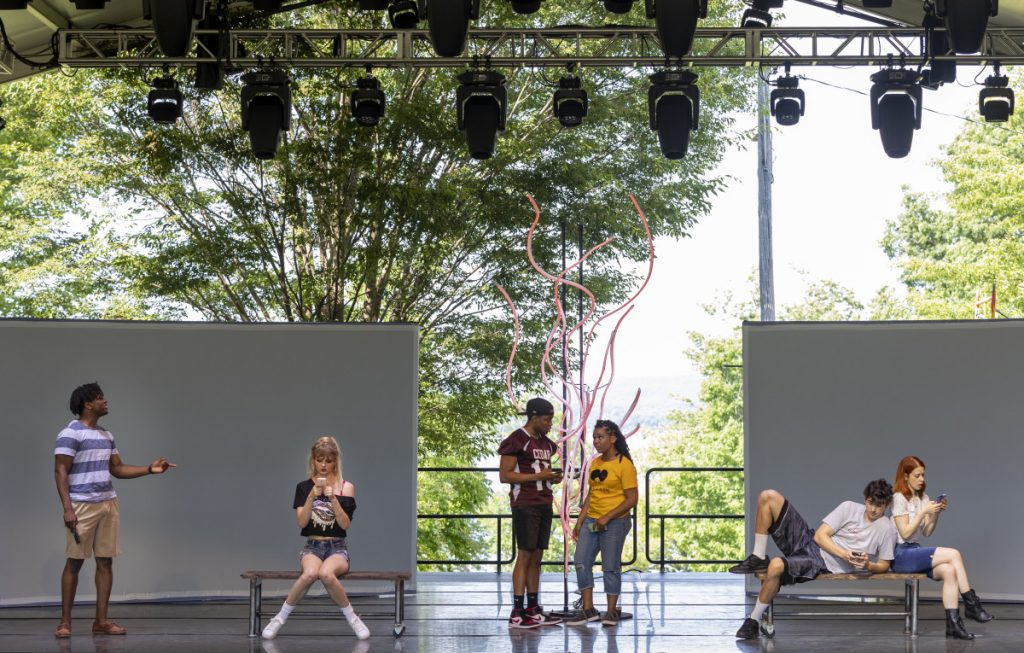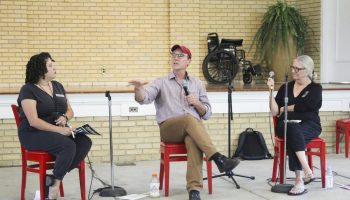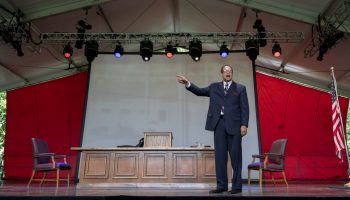DAVID KWIATKOWSKI – STAFF WRITER

“Way somebody choose not to sit next to somebody in the lunchroom — got roots. Way somebody got problems with the flag somebody else wear on they T-shirt — got roots. Way some people talk the way they talk, or hang out with who they hang out with, or love who they love, or hate who they hate — all got roots.”
– Colin, Blood at the Root
The word “root” can be defined in multiple ways. As a part of a plant; something attached to a greater part of a whole; family, ethnic or cultural origin; or as something established deeply into society.
Chautauqua Theater Company’s first production this season, Blood at the Root, continues its run at 4 p.m. Saturday, July 3 at the Performance Pavilion on Pratt. Saturday’s performance includes a panel discussion after the show.
The show is loosely based on the events of the Jena Six, a group of Black teenagers who were originally charged with attempted murder and tried as adults after being accused of fighting a white teenager at Jena High School in Louisiana in 2006.
While the case was underway, many news organizations and commentators believed that the Jena Six were being treated unfairly and harshly and that racial tensions had reached a boiling point at Jena High School.
The play was written by Dominique Morisseau for the 2014 graduating acting class at Pennsylvania State University and for CTC’s production, they have an original cast member at the helm to direct.
Stori Ayers, associate artistic director of CTC, originated the lead role of Raylynn and is directing Blood at the Root for the second time.
While the show addresses the events of 2006, Blood at the Root is not tied to any specific time period and follows six characters’ different journeys in Cedar High School, trying to navigate the polarized, segregated climate amongst the students.
For instance, to make a point, the characters Raylynn and her brother De’Andre make plans to sit under the tree that all the white, popular students at the school typically use. The next day, three nooses hang from the tree. This divides the characters in whether or not the nooses are a racially-motivated threat or an average prank.
Scenic Designer Efren Delgadillo Jr. designed the sets for all of CTC’s productions this season and worked with Ayers on the tree and the projections in the show. However, with COVID-19 restrictions, he had to get creative in designing sets.
“A lot of these designs were led by instinct,” Delgadillo said. “When I read Blood at the Root and with it being outdoors, it all had to be compressed.”
He had originally wanted the tree to be a big, abstract branch coming in from outside but adjusted it to be a lit-up sculpture.
“Stori mentioned that she wanted a bold statement on stage,” Delgadillo said. “To capture (the tree) in the form of a light when it provides shade worked in my head. The tree is a gestural object that’s trying to make a statement.”
Ayers’ mother, Angela Fields, has seen Ayers in the show both when she was at Penn State and at the Kennedy Center in Washington D.C., and believes Blood at the Root is powerful in showcasing the Black experience in America to a non-Black audience.
“That play isn’t something that’s new as an African- American person,” Fields said. “It’s something that we lived. It’s something that we’ve all experienced. Bringing it to the arts and sharing it with the world, it feels good to let everybody know of our paths and our struggles and to acknowledge what we have gone through in this country. I am glad that at this moment in time, we have the opportunity to bring this kind of work to the stage.”




